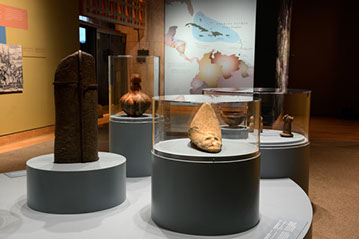
Tainos at the Smithsonian
ABOUT US |
A new Smithsonian exhibition aims to upend the long-held view that the indigenous Taíno cultures in the Caribbean vanished after Spanish colonization. Organized with the Smithsonian Latino Center (SLC), “Taíno: Native Identity and heritage in the Caribbean” will be on display through October 2019 at the National Museum of the American Indian’s (NMAI) George Gustav Heye Center in New York City, where as much as one third of the population claims Caribbean ancestry.
“We considered the story of the conquest and colonization of the Greater Antilles to be one of the most important [chapters] in human history,” said Ranald Woodaman, SLC exhibitions and public programs director and co-curator of the Taíno exhibition, “but we needed to retell it from the perspective of native survival and living legacies. In other words, we didn’t want to do just another archaeology show; instead, we wanted to flip the Columbus story on its head and focus on native legacies after 1492 and the relevance of native knowledge in the present. For a decade I collaborated with the Museo del Hombre Dominicano in Santo Domingo, repository of one of the foremost Taíno collections. While showcasing archeological artifacts, the museum infrequently linked them to contemporary Dominican society, reflecting what one prominent scholar had called the “rise and decline of the people who greeted Columbus.”
Since the Dominican museum opened in the 1970s, however, a more nuanced view of the Taínos has taken root in  the Spanish-speaking Caribbean islands and their diasporic communities in the U.S. It reflects a growing interest in the historical, cultural and genetic legacies of these native peoples. As individual, families and organizations affirm a native ancestry, a diverse Taíno movement has emerged. Today, Taíno has been embraced by many Caribbean people with native ancestry as a way to unite their historical experiences and cultural identities before and after 1492.
the Spanish-speaking Caribbean islands and their diasporic communities in the U.S. It reflects a growing interest in the historical, cultural and genetic legacies of these native peoples. As individual, families and organizations affirm a native ancestry, a diverse Taíno movement has emerged. Today, Taíno has been embraced by many Caribbean people with native ancestry as a way to unite their historical experiences and cultural identities before and after 1492.
I sat down with Woodaman to discuss how the exhibition spans what he described as a fundamental disconnection between the islands’ peoples today and their cultural if not also genetic ancestors. The exhibition opens, to be sure, with iconic artifacts from the NMAI collection, notably over thirty cemis, stone,wooden and even cotton ritual figures used by the Taíno to connect with deities and ancestors. But the exhibit does not stop there and even includes a contemporary skateboard decorated with Taíno iconography.
“It’s amazing,” according to Woodaman, “to see how alive the presence of the Caribbean’s First Peoples is in the hearts and souls of their descendants,” adding that they are “excited by Taíno legacies because these are so deeply ingrained in the spirituality, geography, iconography, folklore and general lifeways of their islands’ familiar rural cultures.”
Documenting that continuing presence is a challenge: The historical record is often problematic. Archival records skew toward a colonial point of view and often don’t document rural life. Church and civil records arguably indicate ancestors’ race. Nonetheless, Cuban researchers have recovered native history from the colonial era into the present; historical texts from Puerto Rico and the Dominican Republic mention native communities into the late 1700s and early 1800s.
Where the native presence persists, Woodman notes, “is in the repertoire…of popular memory, family histories folk stories [and] regional lore,” not to overlook linguistic links. Hammock, barbecue and canoe are just some of the Taíno words that have migrated into Spanish and English.
Woodman hopes the exhibition will impact the way race is discussed among Caribbean communities, “opening a space for the conversation about what this means for ancestry and history.” He acknowledges that tackling “mestizaje (genetic and cultural mixing over time), reclamation and and revival was intimidating.” For many Latinos of mixed racial or ethnic heritage, he says, this is a contested heritage; some fear that embracing a contemporary sense as Taíno diminishes the contributions of African ancestors to national culture or personal identity.
Woodaman asserts, to the contrary, that the Taíno movement, not unlike aspects of the Chicano movement, says just the opposite, that descendants have a right to reclaim and reconstruct this heritage, and that it is integral to their sense of spiritual and cultural wholeness.
The directors of the two organizing institutions have highlighted the importance of this exhibition. Kevin Gover, director of the National Museum of the American Indian, noted that “this exhibition traces a dark history that inspiringly evolves into a flourishing present that won’t allow the Taíno legacy to be erased.” Smithsonian Latino Center director Eduardo Díaz added, “for us, it was important to push through the myth of extinction and explore the historical and living legacy… I cannot think of a more important, or original, American story to share.”
John Coppola